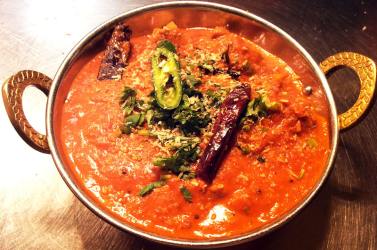Vindaloo

Vindaloo is an Indian curry dish popular in the region of Goa. The cuisine
of the Mumbai region also includes a variation of the dish. However, it is
known globally in its Anglo-Indian form as a staple of curry house menus,
often regarded as a fiery spicy dish, though it is not necessarily the
hottest dish available.
History
The name "vindaloo" is derived from the Portuguese dish "carne de vinha
d'alhos," which is a dish of meat, usually pork, with wine and garlic. The
Portuguese dish was modified by the substitution of vinegar (usually palm
vinegar) for the red wine and the addition of red Kashmiri chillies with
additional spices.
Nowadays, the Anglo-Indian version of a Vindaloo is marinated in vinegar,
sugar, fresh ginger and spices overnight and then cooked with the addition
of further spices. The end result has a 'sweet sour' taste which is quite
different from that adapted by UK restaurants.
Preparation and Variations
Restaurants often serve this dish with chicken or lamb sometimes mixed with
potatoes. Traditional Vindaloos do not include potatoes, although the word "aloo"
does mean "potato" in Hindi.
Vindaloo is a popular dish in many parts of India.
Outside South Asia
Vindaloo has gained popularity outside of India, where it is almost
universally featured on Indian restaurant menus. Vindaloo served in western
restaurants differs from the original dish of that name in that it is simply
a hotter version of the standard "medium" restaurant curry, with additional
chili and including potatoes. Despite its origins, Vindaloo in Britain is
usually not available with pork, only with chicken, beef, lamb/mutton, or
prawn.
Vindaloo is one of the hottest dishes available on the menu where it is
served, although some establishments serve a "tindaloo" in addition, which
is a completely different dish originating in Bangladesh. The Bengali
tindaloo is a step up from Vindaloo in terms of spiciness, with the addition
of more chilies. Another hotter curry is the "phall". These two dishes are
sometimes omitted from the menu, because they are regarded too hot for the
majority of diners, but can be prepared by special request.
Sources: Wikipedia
undo ...back